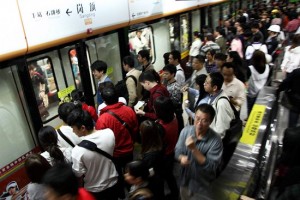In a country struggling with a widening wealth gap and perceptions of ill-gotten wealth, why not launch a two-tiered public transport system?
Okay, that might be a little harsh, but Shenzhen is indeed pressing ahead with plans to launch a VIP car on its new metro line 11, which is scheduled to open in 2016. Tickets for the VIP area will be double the price of regular tickets.
China Daily is on the case with some reaction:
“We are trying to make public transportation meet a higher level of service,” said Zhao Penglin, deputy secretary general of Zhenzhen municipal government, at the Shenzhen-Hongkong Subway Economic Circle Summit on July 5.
“By providing seat tickets to passengers, especially travelers from other places, a morecomfortable journey can be enjoyed,” Zhao said.
But some passengers remain skeptical about the VIP service.
“I will consider the VIP ticket if it is not expensive,” said a Shenzhen woman surnamed Huang, “It’s crowded in rush hour, making it difficult to stand without a seat from the Laojie station tothe airport for 40 to 50 minutes, and I am willing to pay more for the ticket for comfort.”
A worker surnamed Lin said, “I go to work by underground on weekdays, and it’s a littleexpensive to spend double the price on a VIP ticket.”
While not common, first-class public transport trains do exist. The most notable is next door in Hong Kong, where the East Rail Line connecting Lo Wu with Hung Hom features first class compartments. Like Shenzhen’s plans, the first class car is roughly double the cost of other train compartments.
No word on what features the first class compartments in Shenzhen will have to justify the added cost. However, it appears it will, at the very least, guarantee the ticket-holder a seat. That’s better than in Hong Kong, where first class passengers have to stand if all seats are full.

 0
0

 1K
1K